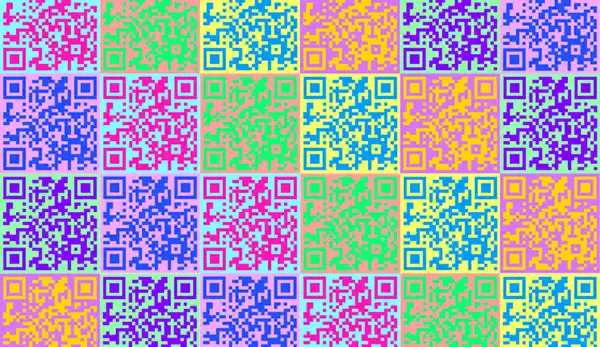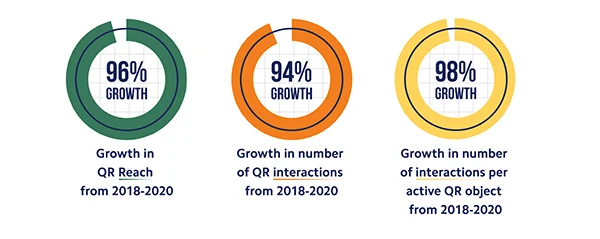
Have you seen any of those weird-looking square code-like things around? You can pretty much see them plastered everywhere these days.
Invented in the early 90’s, QR codes have been around for more than a decade and they have become popular lately, especially with brands and marketers.
So, what exactly is a QR code?
Well, a QR code, or quick response code, is kind of like a barcode. It’s just arranged in a square shape and is used to store data like links to websites, social media profiles, restaurant menus, songs, and much more.
And the best part is that anyone with a link can easily create a QR code with an online generator.
Heck, you can even create a Facebook QR code for your Facebook page and promote it on your social media or you can simply print it on a sticker and spread it around.
How Does The QR Code Work?
Since it is just like a barcode, any scanner, smartphone, or iPhone can be used to scan and access the content stored within the QR code.
It uses pixels arranged in a square grid to store data and information, like links to anything on the web.
But when they are scanned, the digital scanner compiles the QR code’s unique pixel pattern and translates it into digital information.
For example, below is a QR code generated with QR Stuff (a free online QR code Generator) and if you scan it, you’re gonna get some pretty nifty info on how a social media virtual assistant can streamline your business.

The QR code was initially invented in 1994 to streamline the car manufacturing process but today it is being used for much more.
This once-dying fad has seen a revival recently in 2017 because of the iOS 11 update, which allowed its users to scan QR codes with the native camera app instead of some third-party app.
People pretty much used to hate QR codes but because of their many use cases, usage data shows that they’re coming back.
DID YOU KNOW?
QR codes, or Quick Response Codes, were invented in 1994 by Denso Wave, a Japanese company that makes automatic identification devices. The codes were originally created to track vehicle parts and inventory management.
So, what exactly makes the QR code so appealing for marketers?
QR Codes and the Future of Marketing
It is 2024 and there is just no stop to the growth of QR codes.
With smartphones in the hands of pretty much everyone, it is a pretty convenient and efficient way for marketers to connect with consumers and drive engagement.
A Shorter Journey Equals a Better Experience
Well, QR codes are pretty much a quick and easy way for consumers to access certain information.
With just a simple scan, they can get a look into things like product details, discounts, and promotions.
Plus, QR codes can be used in any type of marketing channel, including ads, billboards, and packaging.
Aside from this, these codes make it easy for digital marketers to see how their marketing efforts are doing by helping them measure the number of scans and conversions.
People do not have that much of an attention span these days. They want everything with just a few clicks.
With QR codes, brands can make themselves more visible in real-time and increase their engagement rates.
For example, a brand can place a QR code on their product packaging and use it to explain how the product is used or they can also use it to get direct feedback from customers about their experience and opinions.
This way, they can work on improving their products and services.
Cost Effective Marketing
Well, QR codes are pretty cheap to create. Heck, you can even create one for free if you use an online QR code generator like QR Stuff.
And because you can print it pretty much anywhere, this makes QR codes pretty versatile for marketers to reach a wider audience with minimal investment.
For example, using QR code menus has allowed many restaurants to save a lot of time and money on printing new menus. And with these all-new digital menus, they are even able to allow their customers to order food and pay directly on their site.
This way, they can pretty much streamline the diner’s experience and focus more on serving the customers faster.
Personalized Marketing
Well, there are some studies online that state that more than 80% of online consumers are more likely to buy from brands that give them a more personal experience.
The answer to this lies in the QR codes too.
By redirecting their users to specific pages based on their interests, brands can give them a more personal experience that will stick with them.
This can not only help in improving the customer experience and loyalty, but they will also be making more sales and improving the overall effectiveness of their marketing efforts.
Augmented Reality
QR codes can also be used to add a touch of AR to marketing campaigns.
By scanning QR codes, customers can see the products live in front of them and they can also interact with them all in a virtual environment.
Still, having an idea of what the product will really look like in their homes will make the customer more likely to make a purchase.
Hey, you can even go to the museum and, with a simple scan of the QR code, see how the first wheel was made or see the T-Rex come to life right in front of you.
A Physically Digital Space
QR codes are becoming pretty accessible and with everyone veering towards more digital options for their payments, many options let you do just that.
People do not need to carry their wallets anymore.
Today, you can simply walk into a store, scan the QR code and you’ll be done with the payment.

The number of smartphone users who used a QR code scanner jumped by almost 20 million between 2020 and 2022. After reaching 88.9 million users in 2022, the technology is projected to hit 94.1 million users by the end of 2023 and exceed 100 million by the close of 2025.
TL;DR
There is no denying that the market for QR codes is helping businesses expand their digital and social media marketing strategies and explore new horizons for business growth.
With good content placement and an eye for strategy, marketers can use QR codes to improve sales and customer engagement, get faster feedback, track conversions, and much more.
Plus, with the ability to monitor and analyze the interactions, they can trace the user behavior and build a personalized experience for their customers.
Aside from this, the use of QR codes can also help businesses serve their entire catalog to customers digitally and they can accept payments with them as well.
As more time passes, the use of QR codes is only going to get even better.







